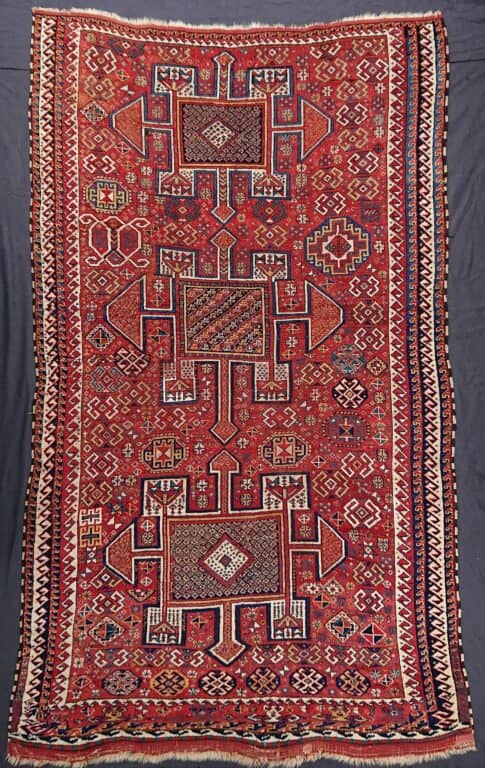Kordi Quchan Rug
Description
This Kordi Quchan rug was made by a Kurdish weaver in Khorasan province in northeastern Iran in the middle of the 19th century.
The three rectangular medallions with angular extensions on all sides appear in a similar rug published in Burns, James, Antique Rugs of Kurdistan. A Historical Legacy of Woven Art. 2002, Plate 99, p. 296. Burns ascribes this rug to the Darreh Gaz region in the Khurasani Exclave and dates it to the middle of the 19th century. Like a lot of the Kurdish rugs from Khorasan, our rug, too, has red wefts, in this case mostly three but in some places as many as five. Another similar example is published in Kordi. Leben, Knuepfen, Weben der Kurden Khorasans, a publication accompanying Adil Besim’s exhibition of carpets in November 1988, on page 81. This carpet is dated to the first half of the 20th century. However, our rug is somewhat older, most probably dating to the middle of the 19th century.
There has been discussion about the origin of these strangely shaped medallions. Jenny Housego calls the design a “hawz”, or “hauzi” design from her translation of the word “hauz” as “water tank”, pools which were, according to her, placed in stylized gardens (see Jenny Housego, Tribal Rugs. 1978, Plate 137, p. 161). Wilfried Stanzer who authored the Besim exhibition publication goes along with this reading. Another reading as the medallions representing formal gardens is referred to by Burns (op. cit. , p. 297). Housego also points out that there are similarities to rugs from eastern Turkey and Caucasian Kazaks, which seems plausible since the Kurds of Khorasan originally came from that part of the world.
Whatever the interpretation, this is an early tribal rug in good original condition. It is a rare find.
SOLD

